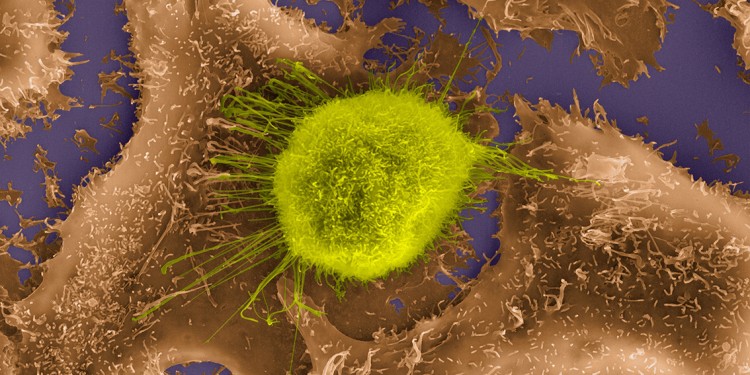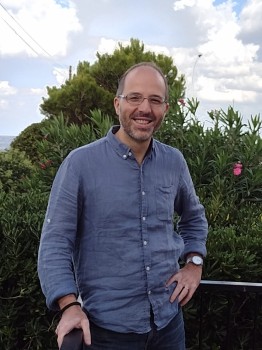
"Consequences for the patient's life"
Dr. Francesco Catania is head of the working group "Evolutionary Cell Biology" at the Institute for Evolution and Biodiversity at the University of Münster. His group uses bioinformatics and experimental approaches to investigate how the interaction of cells and organisms with their environment leads to the emergence of new properties. In an interview with Christina Hoppenbrock, he explains what the question of the evolution of cancer cells has to do with possible treatment approaches.

First off, oncologists see cancer as a disease. However, from a cell's perspective, cancer is not a disease. It is rather an adaptation to its microenvironment.
My team studies how organisms react and adapt to environmental changes. The environment is not simply the world outside an individual. It can also be inherent to an individual. In this latter case, circumstances that facilitate the emergence of diseases such as cancer, like healthy tissue becoming chronically inflamed, can be viewed as environmental change. Over the past few years, we have found that new environmental conditions trigger a cellular response that may promote biological adaptation.
Thus, environmental change may promote both disease emergence and adaptation. If this is true, then understanding the mechanisms that drive biological adaptation could also help us better understand how diseases like cancer emerge.
Usually, the development of cancer cells is interpreted in the tradition of Darwinian evolutionary theory ...
When it comes to the question of how cancer cells adapt to their microenvironment, most biologists think of Darwinian evolution. According to what is known as the neo-Darwinian model, DNA changes with a selective advantage can spread through a population. The neo-Darwinian mechanism offers a convincing explanation of how living beings adapt to their environment. It is therefore not surprising that Darwinian evolution is also widely assumed to explain the success of cancer.
However, you doubt that the resistance mechanisms observed in cancer therapies can be adequately explained in this way. What makes you doubt?
Not all the empirical data readily agree with the prevailing neo-Darwinian mechanism. Therefore, we asked ourselves: Does the neo-Darwinian mechanism offer the only plausible explanation for the emergence of evolutionary adaptations?
And what model do you propose instead?
In a paper we recently published in Frontiers in Oncology, we revive and extend an overlooked but very powerful non-Darwinian mechanism for the origin of evolutionary adaptations. This mechanism of adaptive evolution is just as valid as the neo-Darwinian one. It may not only provide new explanations for the onset of cancer, but also offer different strategies for clinical interventions to counteract therapy resistance. We call it "use it or lose it."
What does this involve?
Adaptation to a new environment can occur through the loss of genes and corresponding phenotypic – i.e. observable – characteristics that are no longer needed in a particular environment. This loss can stabilise the increased activity of genes that are used in the new environment and that regulate the expression of adaptive phenotypes. Think of our missing tail. Most living primates have a tail, but humans and apes do not. Why is that? Neo-Darwinism would look for the direct evolutionary advantage of a missing tail. According to the “use-it-or-lose-it” mechanism, the tail was lost because it was no longer needed. The “use-it-or-lose-it” mechanism opens up the possibility that the loss of the tail may have indirectly favoured the establishment of adaptive phenotypes.
What does this mean for the topic of cancer? Do we need to rethink therapies?
The neo-Darwinian and the “use-it-or-lose-it” mechanisms are equally plausible. However, choosing one or the other mechanism can have serious consequences for the patient's life.
Imagine a person who is routinely exposed to chemotherapy. According to the neo-Darwinian model, cancer cells may evolve resistance to this therapy due to the rare occurrence of spontaneous beneficial mutations. According to the “use-it-or-lose-it” model, adaptation is achieved by silencing the cellular functions that are unused in the within-body environment that the therapy promotes. This silencing is achieved through non-rare epigenetic and genetic changes that preferentially accumulate in weakly expressed or non-expressed genes. It is also causally coupled with increased cell proliferation. Therefore, the fact that cells become resistant to therapy may not be the result of rare advantageous mutations. Rather, it may be the direct consequence of the therapy and/or the suppression of the body's immune system associated with the therapy.
What does this mean for the treatment of cancer patients?
Oncologists relying on the neo-Darwinian explanation might decide to give cancer patients an even higher dose of chemotherapy to fight the cancer cells that have evolved resistance. According to the “use-it-or-lose-it” explanation, a mild and possibly personalised dose of chemotherapy should make it more difficult for resistance to emerge. At the same time, it could continue to allow the immune system to rid the body of cancer cells.
This interview is from the university newspaper wissen|leben No. 7, 10 November 2021
Original publication:
Francesco Catania et al. (2021): Bridging Tumorigenesis and Therapy Resistance with a Non-Darwinian and Non-Lamarckian Mechanism of Adaptive Evolution. Frontiers in Oncology. DOI: 10.3389/fonc.2021.732081
